Numerical Simulation for the Desired Compatibility between the Inside Slopes of Open Irrigation Canals, and the Used Type of Wing Walls for the Most Efficient Performance of Water Structures
Abstract
1. Introduction
- ▪
- The optimal transition angle (θ) for broken-type wing walls in water structures is 30 degrees.
- ▪
- Wing walls and abutments with smaller dimensions (width and length) generate stronger vortices and downflow compared to those with larger dimensions.
- ▪
- There is a lack of studies exploring the relationship between the inside slope of the canal and the wing wall of water structures.
- ▪
- Only a few authors have investigated a complete model of water structures, such as the U.S. wing wall, abutment, and D.S. wing wall, which represents a practical model closer to reality.
2. Methods
2.1. Methodology
2.2. Selection of Experimental Data from Previous Work
2.3. Dimensional Analysis
- Fluid characteristics: ρ is the water density (kg/m3); μ is the dynamic viscosity (kg/ms) and ơ is the surface tension (kg/s2).
- Geometry Characteristics: B is the original channel width (m); b is the design structure width (m); θ is the transition angle of the U.S. wing wall; S is the bed slope of the channel; L is the abutment length of the structure (m) and Z is the side slope of the channel (H:V), (horizontal to vertical).
- Flow characteristics: ∆E is the total energy loss; (m); V1 is the U.S. water velocity; (m/s); V2 is the water velocity through the structure (m/s); V3 is the D.S. water velocity (m/s); g is the acceleration of gravity (m/s2); Q is the discharge (m3/s); y1 is the U.S water depth(m); y2 is the water depth through the structure (m); y3 is the D.S water depth (m); Q* is the discharge factor (dimension less) and hu is the afflux (heading up) (m).
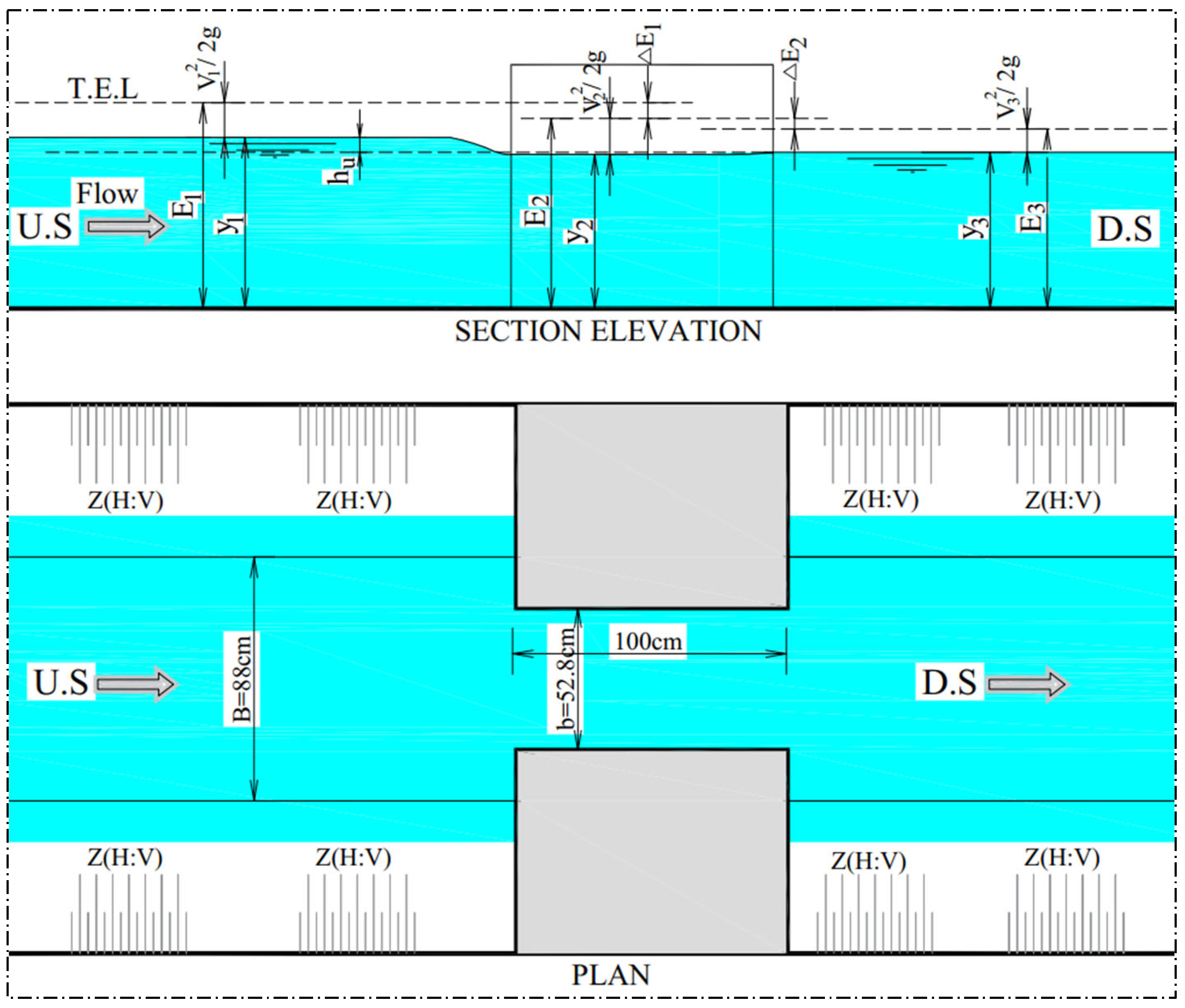
2.4. Numerical Simulations Using HEC-RAS
2.5. Validation Study of Numerical Simulations with Previous Experimental Measurements
3. HEC-RAS Modeling for Different Canal’s Inside Slopes with Different Types of U.S Wing Wall
Analysis and Discussion
4. Conclusions
Author Contributions
Funding
Data Availability Statement
Acknowledgments
Conflicts of Interest
References
- Tank, Y.R.; Patel, A.S.; Patel, P.A.; Tank, A.R. Experimental Study of Ugat Canal Soil for Slope Stability. In Proceedings of the Indian Geotechnical Conference 2019: IGC-2019 Volume I; Springer: Singapore, 2021; pp. 623–634. [Google Scholar]
- Salunkhe, D.P.; Bartakke, R.N.; Chvan, G.; Kothavale, P.R.; Digvijay, P. An overview on methods for slope stability analysis. Int. J. Eng. Res. Technol. 2017, 6, 181–2278. [Google Scholar]
- Mowafy, M.H.; ELdeeb, H.M.; Salem, M.N.; ALquamhawy, A.Y. Factors affecting on stability of waterways embankments. Int. J. Eng. Res. 2015, 4, 700–705. [Google Scholar]
- Abdel-Aal, G.M.; Owais, T.M.; Shahin, M. Effect of side slopes of trapezoidal channel on maximum scour depth downstream of transition. In Proceedings of the ICFDP9: Ninth International Congress of Fluid Dynamics & Propulsion, Alexandria, Egypt, 18–21 December 2008. [Google Scholar]
- Afzalimehr, H.; Moradian, M.; Singh, V.P. Flow field around semielliptical abutments. J. Hydrol. Eng. 2018, 23, 04017057. [Google Scholar] [CrossRef]
- Hadi, A.M.; Ardiclioglu, M. Investigation of bridge afflux on channels by experiments and HEC-RAS package. Int. J. Eng. Technol. 2018, 7, 4829–4832. [Google Scholar]
- Setyandito, O.; Michael, R.D.A.; Andrew, J.P.; Wijayanti, Y. The effect of bridge abutment shape variation toward flow velocity characteristic. In IOP Conference Series: Earth and Environmental Science; IOP Publishing: Bristol, UK, 2020; p. 12035. [Google Scholar]
- Mulahasan, S.; Al-Osmy, S.; Alhashimi, S. Modelling of flow pattern in an open channel with sidewall obstruction. In IOP Conference Series: Materials Science and Engineering; IOP Publishing: Bristol, UK, 2021; p. 12097. [Google Scholar]
- Barbhuiya, A.K.; Dey, S. Velocity and turbulence at a wing-wall abutment. Sadhana 2004, 29, 35–56. [Google Scholar] [CrossRef][Green Version]
- Barbhuiya, A.K.; Dey, S. Measurement of turbulent flow field at a vertical semicircular cylinder attached to the sidewall of a rectangular channel. Flow Meas. Instrum. 2004, 15, 87–96. [Google Scholar] [CrossRef]
- Atabay, S.; Haji Amou Assar, K.; Hashemi, M.; Dib, M. Prediction of the backwater level due to bridge constriction in waterways. Water Environ. J. 2018, 32, 94–103. [Google Scholar] [CrossRef]
- Farsirotou, E.; Xafoulis, N. Numerical simulation of scour depth variation around vertical wall abutments. World J. Res. Rev. 2017, 5, 262723. [Google Scholar]
- Noor, M.; Arshad, H.; Khan, M.; Khan, M.A.; Aslam, M.S.; Ahmad, A. Experimental and HEC-RAS modelling of bridge pier scouring. J. Adv. Res. Fluid Mech. Therm. Sci. 2020, 74, 119–132. [Google Scholar] [CrossRef]
- Mehta, D.J.; Yadav, S.M. Analysis of scour depth in the case of parallel bridges using HEC-RAS. Water Supply 2020, 20, 3419–3432. [Google Scholar] [CrossRef]
- Silvia, C.S.; Ikhsan, M.; Wirayuda, A. Analysis of scour depth around bridge piers with round nose shape by HEC-RAS 5.0. 7 software. In Journal of Physics: Conference Series; IOP Publishing: Bristol, UK, 2021; Volume 1764, p. 012151. [Google Scholar]
- Ardiclioglu, M.; Hadi, A.M.; Periku, E.; Kuriqi, A. Experimental and numerical investigation of bridge configuration effect on hydraulic regime. Int. J. Civ. Eng. 2022, 20, 981–991. [Google Scholar] [CrossRef]
- Nassar, M. The Afflux Calculation Under Effect of Different Number of Vents Experimentally and Using HEC-RAS. J. Eng. Sci. 2023, 51, 81–92. [Google Scholar]
- Ashour, M.A.; Aly, T.E.; Mostafa, M.M. Effect of canal width contraction on the hydraulic parameters and scour downstream water structures. Ain Shams Eng. J. 2019, 10, 203–209. [Google Scholar] [CrossRef]
- Fakhimjoo, M.S.; Ardeshir, A.; Behzadian, K.; Karami, H. Experimental investigation and flow analysis of clear-water scour around pier and abutment in proximity. Water Sci. Eng. 2023, 16, 94–105. [Google Scholar] [CrossRef]
- USACE HEC. HEC-RAS River Analysis System User’s Manual, Version 6.0; USACE HEC: Washington, DC, USA, 2021.
- Brunner, G.W. HEC-RAS 5.0 User’s Manual. US Army Corps of Engineers, Institute for Water Resources, Hydrologic Engineering Center: Washington, DC, USA, 2016. [Google Scholar]

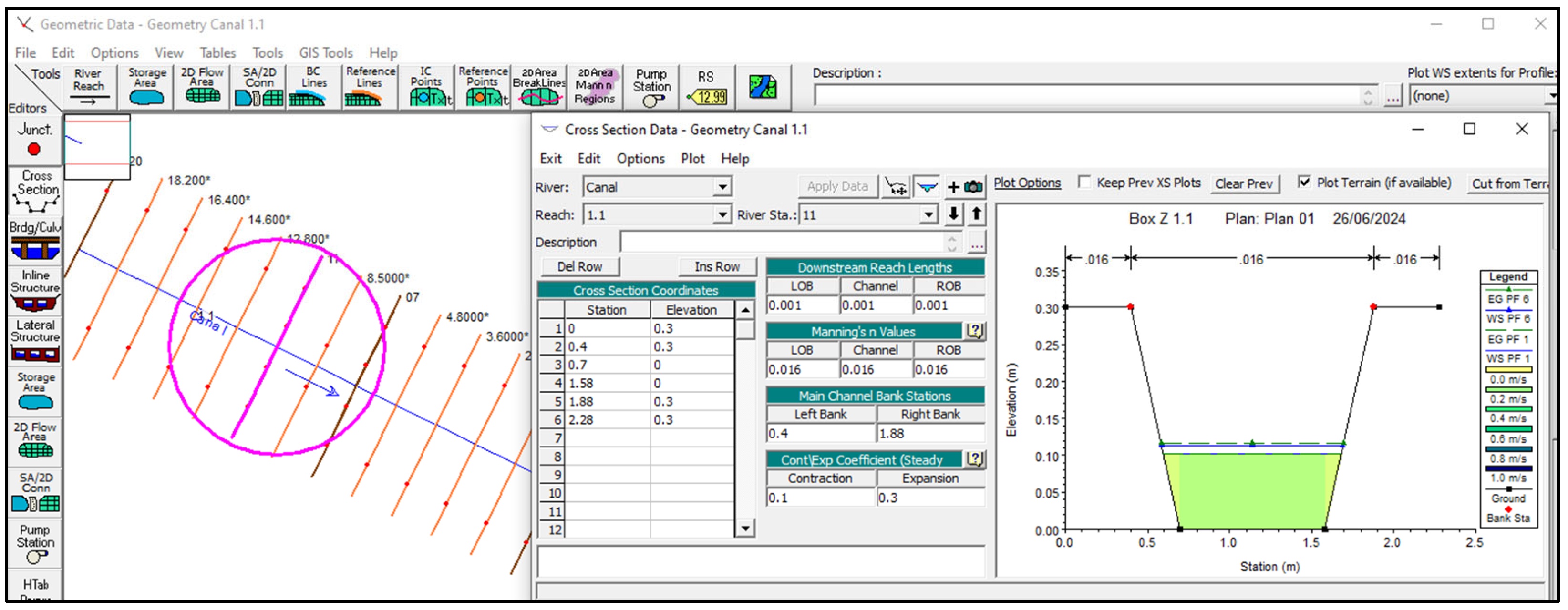



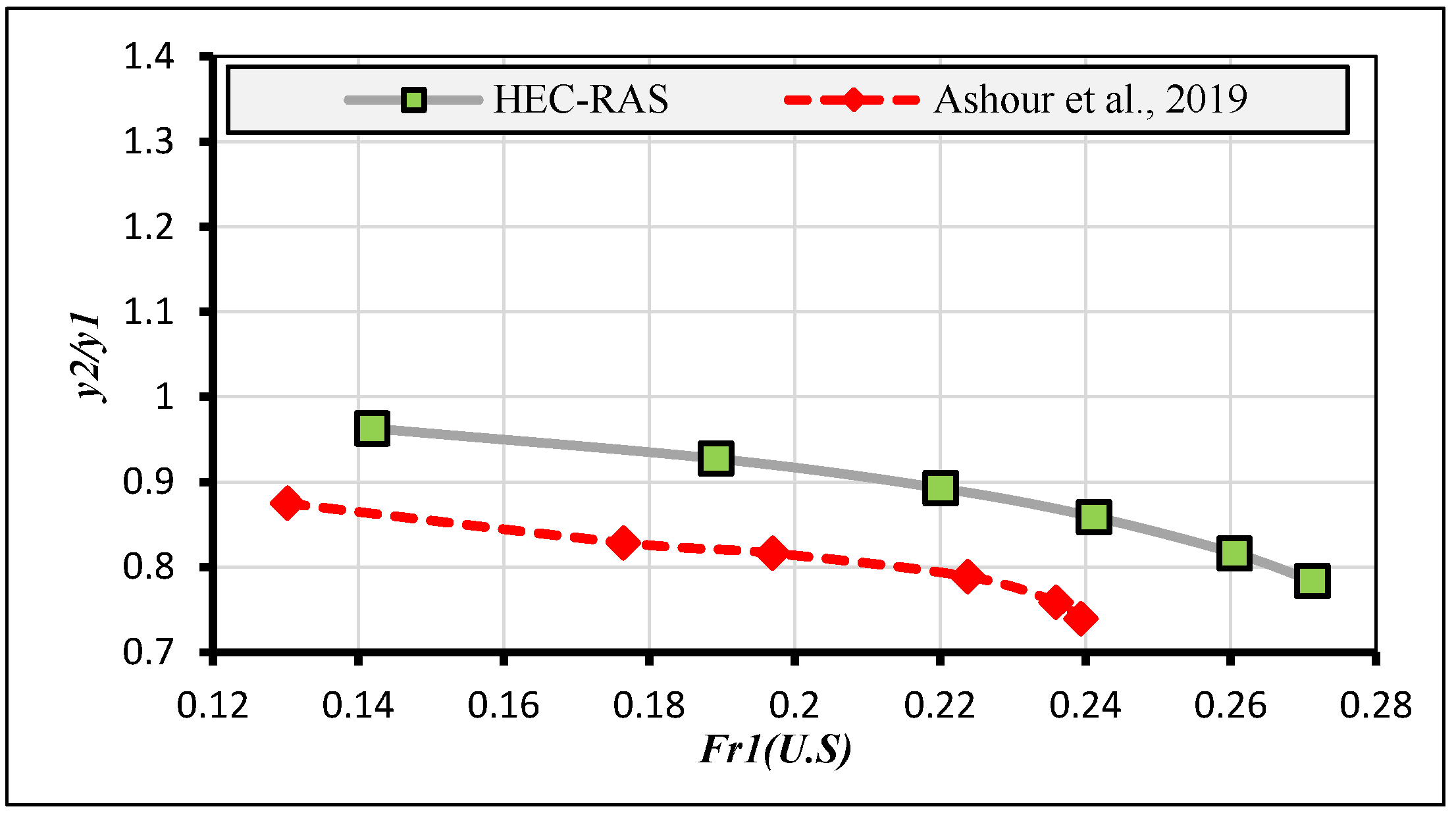
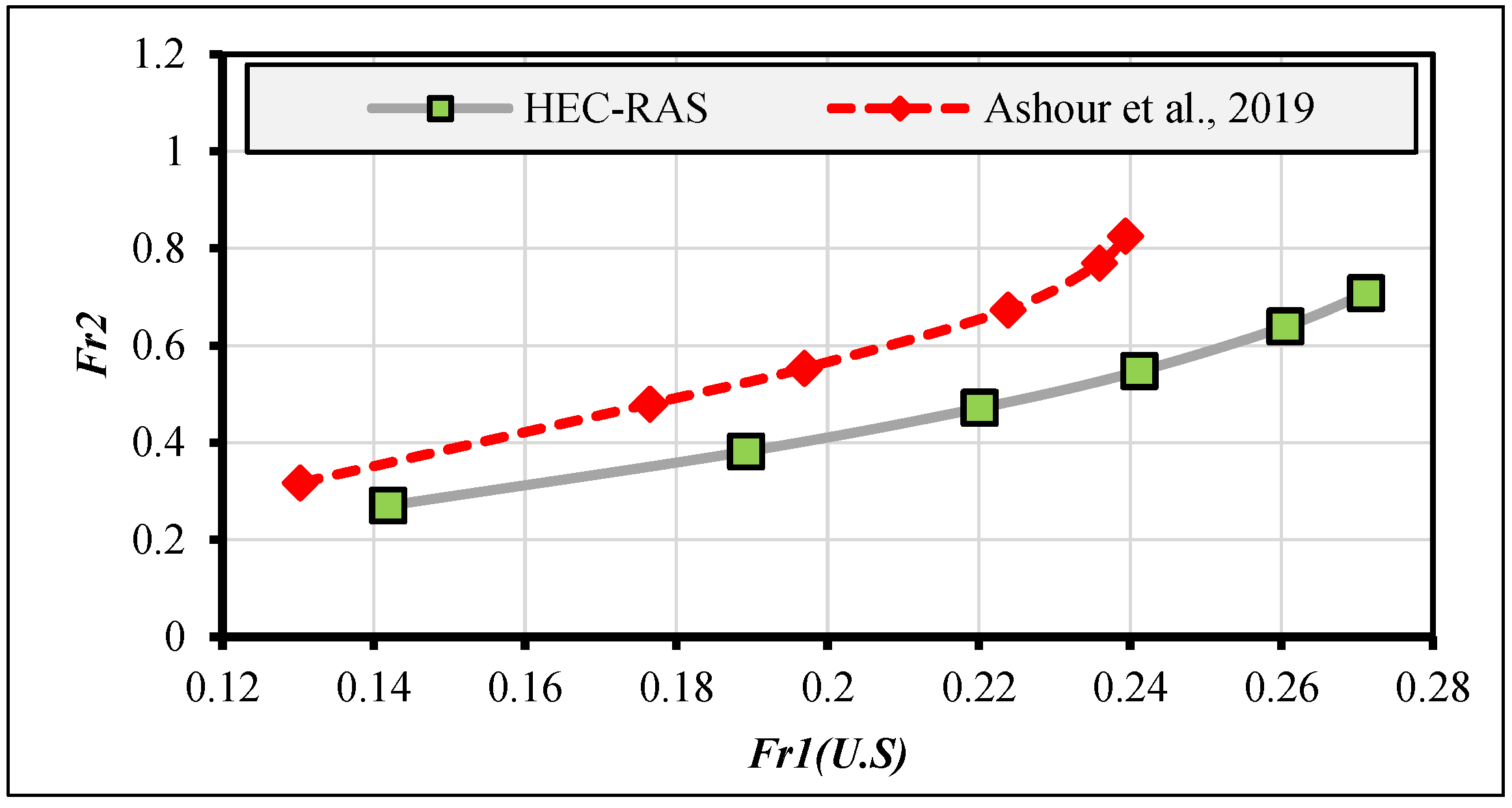
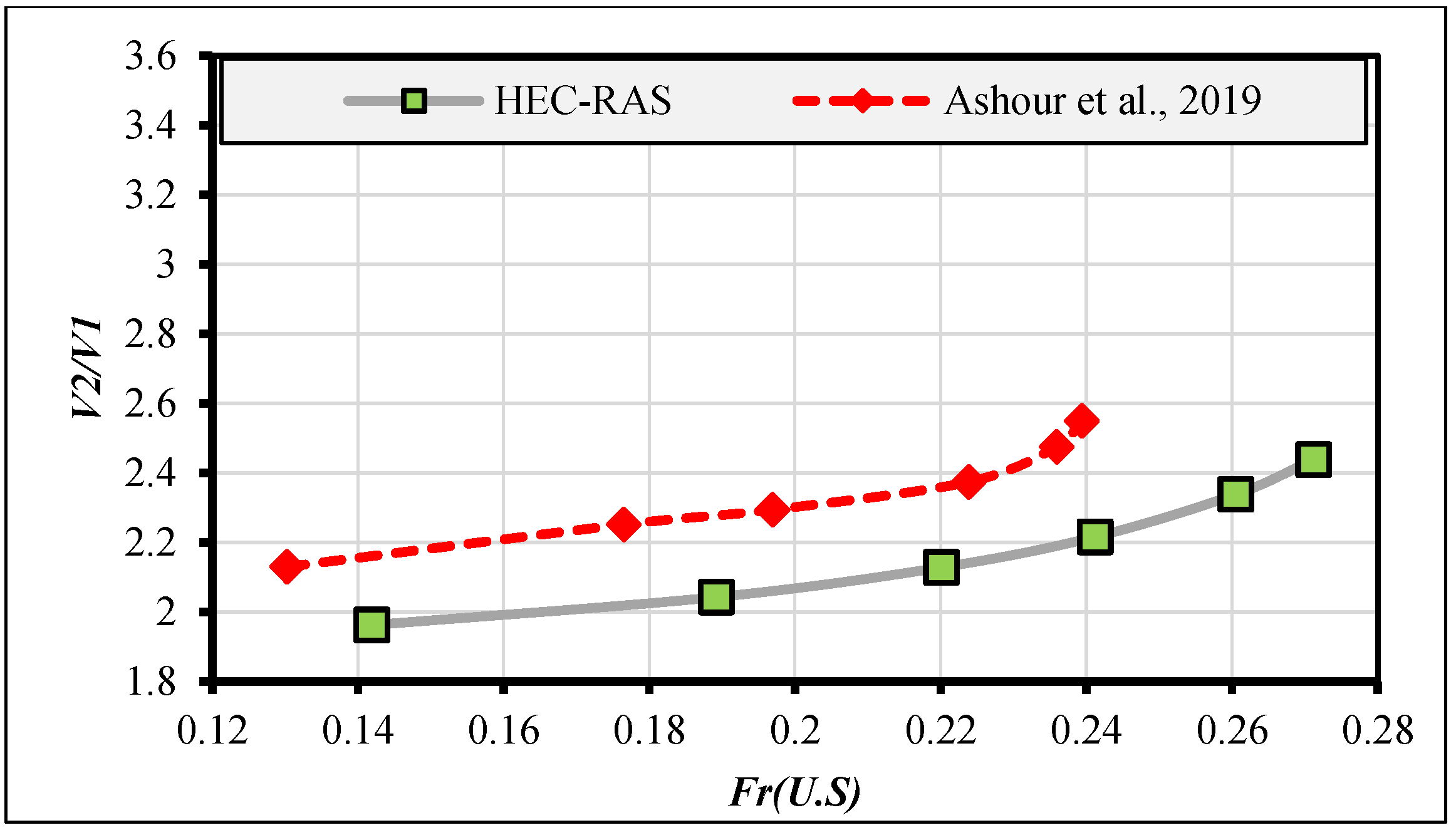
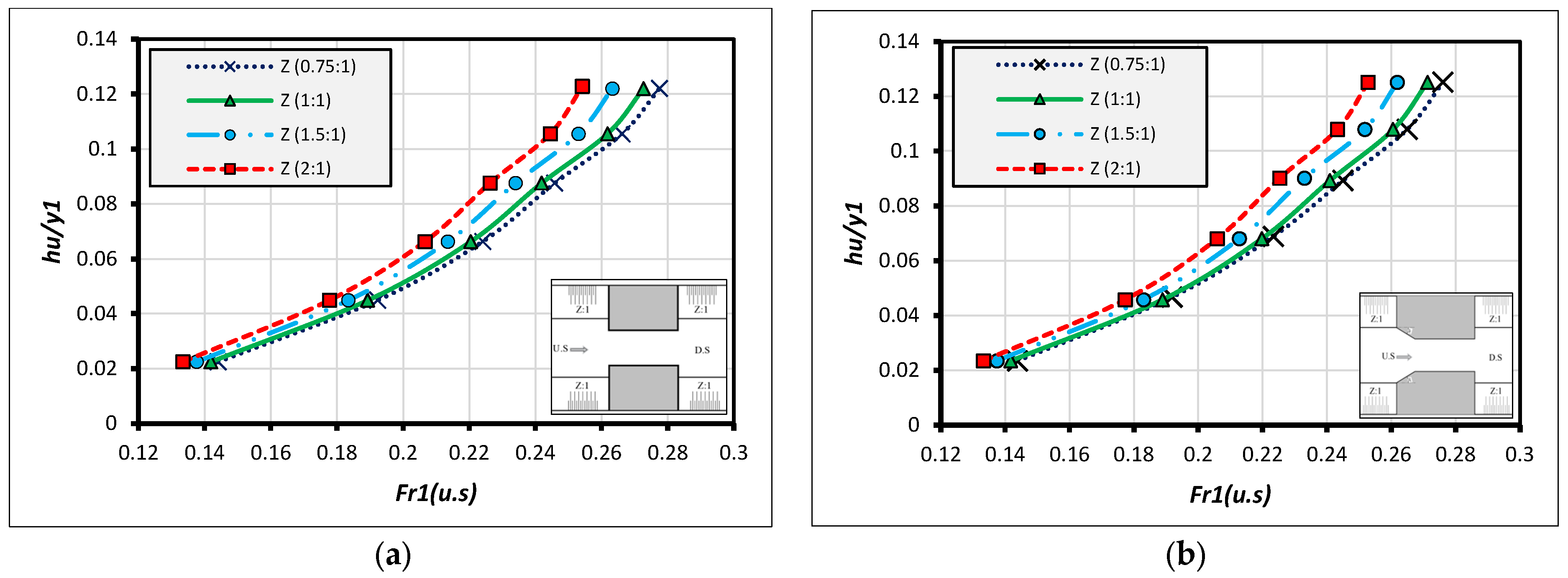






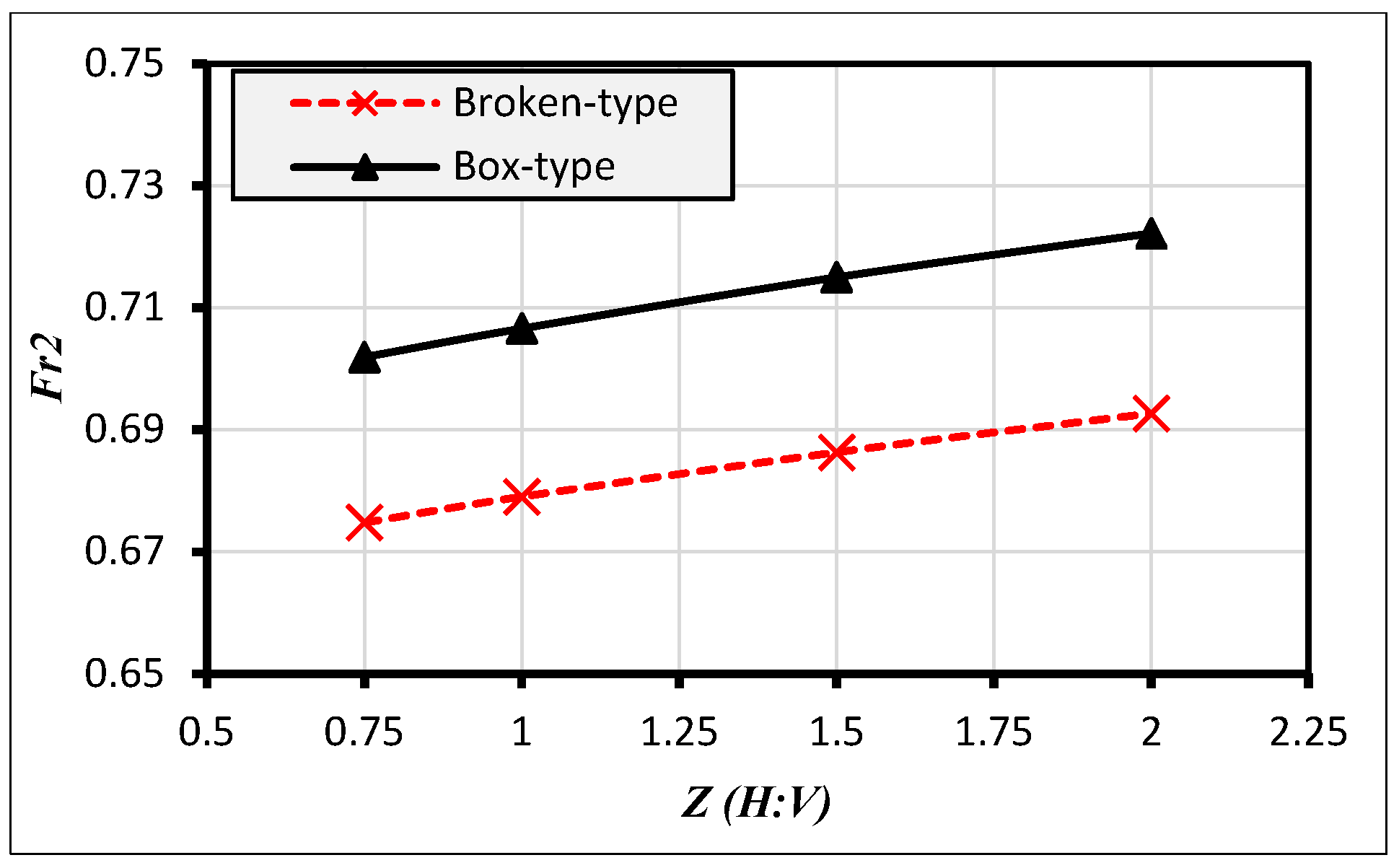
| Conditions | Manning Coefficient (n) | Contraction Ratio (r = b/B) | Side Slope (Z) (H:V) | Discharge Q (l/s) | U.S Water Depth y1 (m) | D.S Water Depth y3 (m) |
| Value | n = 0.016 | 0.60 | 0.75:1 1:1 1.5:1 2:1 | 13.60 | Normal depth (S = 0.001) | 0.01 m |
| 18.8 | ||||||
| 22.70 | ||||||
| 25.80 | ||||||
| 28.80 | ||||||
| 30.90 | ||||||
| Sketch |  |  | ||||
| Box-type wing wall | Broken-type wing wall | |||||
Disclaimer/Publisher’s Note: The statements, opinions and data contained in all publications are solely those of the individual author(s) and contributor(s) and not of MDPI and/or the editor(s). MDPI and/or the editor(s) disclaim responsibility for any injury to people or property resulting from any ideas, methods, instructions or products referred to in the content. |
© 2024 by the authors. Licensee MDPI, Basel, Switzerland. This article is an open access article distributed under the terms and conditions of the Creative Commons Attribution (CC BY) license (https://creativecommons.org/licenses/by/4.0/).
Share and Cite
Ashour, M.A.; Abueleyon, H.M.; Khairy Ali, M.; Abdou, A.A.; Abu-Zaid, T.S. Numerical Simulation for the Desired Compatibility between the Inside Slopes of Open Irrigation Canals, and the Used Type of Wing Walls for the Most Efficient Performance of Water Structures. Limnol. Rev. 2024, 24, 192-204. https://doi.org/10.3390/limnolrev24030011
Ashour MA, Abueleyon HM, Khairy Ali M, Abdou AA, Abu-Zaid TS. Numerical Simulation for the Desired Compatibility between the Inside Slopes of Open Irrigation Canals, and the Used Type of Wing Walls for the Most Efficient Performance of Water Structures. Limnological Review. 2024; 24(3):192-204. https://doi.org/10.3390/limnolrev24030011
Chicago/Turabian StyleAshour, Mohamed A., Haitham M. Abueleyon, M. Khairy Ali, Abdallah A. Abdou, and Tarek S. Abu-Zaid. 2024. "Numerical Simulation for the Desired Compatibility between the Inside Slopes of Open Irrigation Canals, and the Used Type of Wing Walls for the Most Efficient Performance of Water Structures" Limnological Review 24, no. 3: 192-204. https://doi.org/10.3390/limnolrev24030011
APA StyleAshour, M. A., Abueleyon, H. M., Khairy Ali, M., Abdou, A. A., & Abu-Zaid, T. S. (2024). Numerical Simulation for the Desired Compatibility between the Inside Slopes of Open Irrigation Canals, and the Used Type of Wing Walls for the Most Efficient Performance of Water Structures. Limnological Review, 24(3), 192-204. https://doi.org/10.3390/limnolrev24030011








